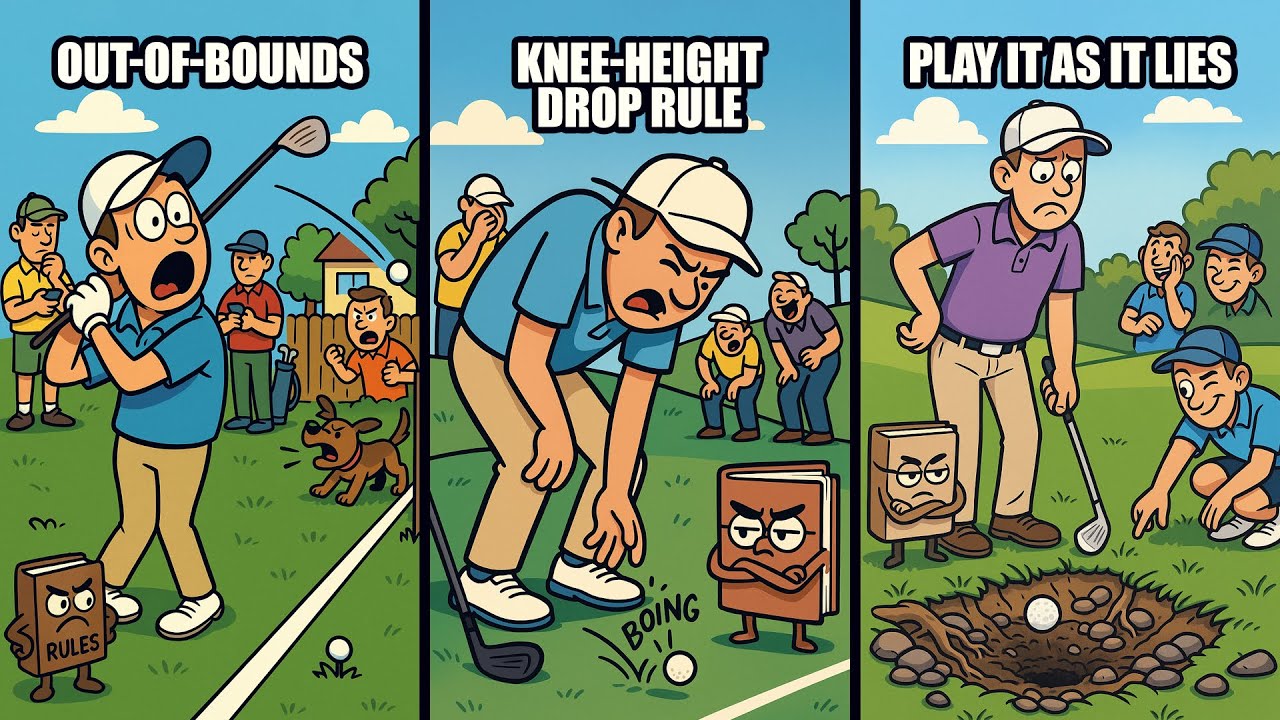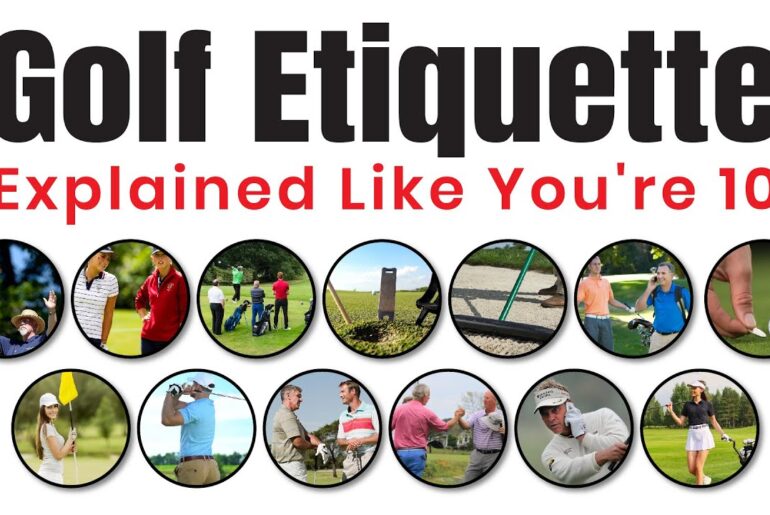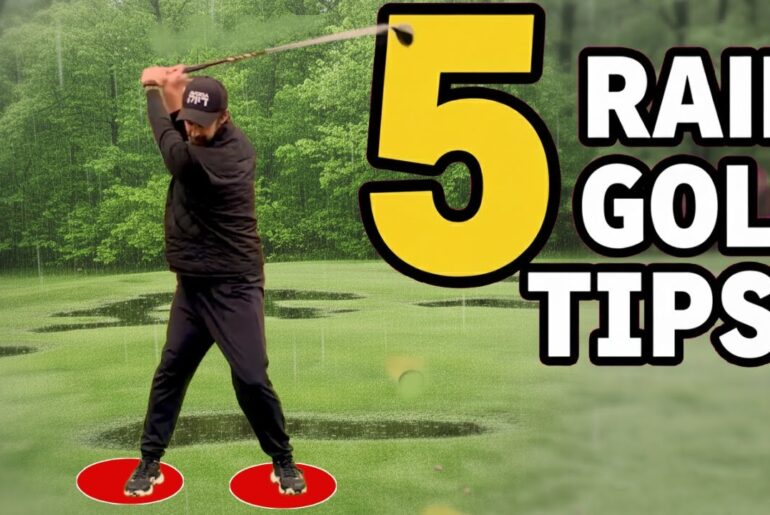Please Subscribe To The Channel and Join Us For Future Videos!
The 7 Golf Rules You Have Permission to IGNORE
#lpga #golf #pga #livgolf
What if I told you there are golf rules you can pretty much ignore and the world won’t end, your buddies won’t care, and your score will actually make more sense? Look, I get it. You’ve been told the rules of golf are sacred, that breaking them makes you some kind of cheater. But here’s the thing nobody wants to admit. Half these rules were written for guys playing for millions on TV, not for you trying to squeeze in 18 holes before your wife realizes you’re not actually running errands. Rules that slow everything down. rules that nobody follows anyway and one rule that might be the dumbest penalty in all of sports. So, which rules can you safely ignore without being that guy? Stick around because I’m about to give you permission to play golf the way it was meant to be played. Fun, fast, and without a rulebook lawyer breathing down your neck. Here’s what the USGA doesn’t want you to know. The rules of golf, they’re made for elite competitive play. Tiger Woods, Rory Mroy, guys who have caddies that know every subsection of every rule by heart. But you’re not Tiger Woods. You’re probably more like me, a weekend warrior who just wants to get through 18 holes before the sun goes down and maybe not embarrass yourself in front of your buddies. Most casual golfers ignore the same handful of rules anyway. And for good reason. These rules don’t make the game more fair. They don’t make it more fun. They just make it slower and more frustrating. Today, we’re going through seven rules that you officially have permission to ignore in your casual rounds. Golf is supposed to be fun, right? It’s supposed to be an escape from all the other rules and regulations in your life. I’ve played in tournaments. I’ve watched more PGA events than I care to admit, and I’ve seen exactly which rules matter for real golf, and which ones are basically optional for 99% of golfers. Let’s start with the rule that every golfer hates, but the USGAA refuses to fix. Lost ball/outbounds rule. The stroke and distance penalty for out-of- bounds or a lost ball. You can ignore this one completely. Here’s how stupid this rule is. Your drive drifts barely out of bounds into someone’s backyard. According to the official rules, you have to walk all the way back to the tea, take a penalty stroke, and hit again. Meanwhile, your playing partners are standing around checking their phones. The group behind you is getting pissed and you’re burning daylight. In casual golf, this destroys pace of play and is never enforced. Never. I’ve played hundreds of rounds with hundreds of different golfers and I can count on one hand the number of times someone actually went back to RET. You know what happens instead? The group says, “Yeah, dude. Just drop it in the fairway and take two.” Problem solved. Game continues. Everyone’s happy. The USGA knows this rule is broken. They even created a local rule alternative because casual golfers were already ignoring the original rule. When the governing body has to create a workaround for their own rule, that’s pretty much admitting it doesn’t work. This is one of the only rules the USGA practically admits doesn’t work for normal golfers. So, why are you still following it? Even the pros think it’s ridiculous. They just have to follow it because there’s money on the line. The knee height drop rule. Dropping the ball from exactly knee height. This is the most ignored rule in modern golf. After the 2019 rule change, everyone was supposed to drop from this awkward knee height. Have you tried this? It’s like they designed it to hurt your back and make you look ridiculous. The USGA changed it from shoulder height to knee height to make drops more consistent. But here’s the thing, nobody wanted more consistent drops. We wanted drops that actually worked. But in casual play, waist drops happen. Shoulder drops happen. Sometimes guys just toss the ball where it needs to go. And you know what? As long as it lands in the relief area, nobody cares. I watched a guy last week try to drop from knee height in a bunker. The ball bounced backward 12 ft. He tried again. Same thing. Finally, his playing partner just said, “Dude, just drop it normally and let’s go.” This rule was designed for consistency in tournaments, not to ruin your back nine. When you’re playing with your buddies on a Saturday morning, drop it however feels natural. The golf gods aren’t watching. The USGA changed the rule, but golfers changed it back. In casual rounds, people drop from whatever height makes sense. And that’s exactly how it should be. Marking your ball. You can mark your ball with anything and nobody should care. The rule book encourages coins, ball markers, small, flat objects, but casual golf is different. I’ve seen guys mark their balls with TE’s, poker chips, bottle caps, and random pieces of gravel they found on the cart path. Last month, someone in my group marked their ball with a giant metal poker chip that looked like a drink coaster. It was blocking everyone’s putting line. We just said, “Hey, maybe rotate that a smidge.” Problem solved. Ball marking is about courtesy, not rule precision. As long as you’re not blocking someone’s line or being a jerk about it, use whatever you want. The only thing that matters is that you can find your spot again. I’ve seen guys mark with quarters with divot tools with random coins from their pocket. One guy I play with uses these tiny plastic armymen. Is it legal? Probably not. Is it hilarious? Absolutely. Does it affect anyone’s score? Not even a little bit. The spirit of marking is simple. Don’t mess up other people’s putts and be able to replace your ball in the same spot. Everything else is just bureaucracy. Use a tea, use a coin, use whatever’s in your pocket. Golf police aren’t coming for you. Fixing imperfections on the green. Fix anything you want on the green. Seriously, before 2019, you couldn’t fix spike marks, scrapes, or raised turf on the green. You had to put around them like they were part of the course design. It was insane. The rule basically said, “Hey, see that heel print from the inconsiderate group ahead? Yeah, that’s your problem now. Now you can fix almost anything. But even if you go beyond that in casual rounds, nobody cares. If there’s a heel print from the group ahead on your putting line, smooth it out. If there’s a ball mark they missed, fix it. If the green looks like a construction zone, do some landscaping. The group ahead left heel prints all over a par three green last weekend. I fixed the whole line and nobody said a word. Why? Because it speeds up play and makes the game more enjoyable for everyone. The only reason this rule ever existed was because the USGAA couldn’t figure out how to enforce it consistently. What counts as a spike mark versus natural imperfection. Who knows? Who cares? In casual golf, we don’t need to enforce it at all. Fix whatever makes sense. Keep the greens in good shape and move on. The course superintendent will thank you. Identifying your ball. You don’t need a custom logo and serial number chart to play golf. Technically, each golfer should mark their ball uniquely so they always know which one is theirs. In reality, half your group plays the same title as Prov1 with a three on it. The other half plays whatever they found in the woods last week. Two buddies in my regular group accidentally played each other’s ball for two holes last month. Nobody noticed until they hit the green. And one guy said, “Wait, why is my three suddenly a one?” We all laughed. They figured out where the switch happened and we kept playing. No penalties, no drama, no rulebook consultation, just golf. The odds of two balls being perfectly identical in the same spot are tiny, unless you’re in deep rough where you can’t see anything anyway. And if that happens, just pick one and move on. This rule only truly matters when there’s money on the line, handicaps being tracked, or officials involved. For Saturday morning golf with your buddies, life’s too short to worry about whether your Callaway has two dots or three dots. Most casual golfers can’t even remember what ball they’re playing until they pick it up on the green anyway. Loose impediments and accidentally moving the ball. The rule everyone overthinks for absolutely no reason. This used to be the most unfair penalty in golf. Touch a leaf near your ball, penalty. Ball moves while you’re removing a twig, penalty. Breathe too hard near your ball in the rough, probably a penalty. In 2019, the USGAA finally admitted this was ridiculous. Now, there’s no penalty if you accidentally move your ball while removing loose impediments, searching for it, or marking it. But casual golfers take massive liberties with this rule anyway, and they should. I watched a guy last weekend whose ball was buried in leaves on a par4. He started clearing debris, accidentally nudged the ball, and immediately panicked. Oh no, is that a penalty? The group just looked at him like he was crazy. Dude, just put it back. The pros do this stuff all the time. Now, here’s the thing. If your ball moves while you’re trying to play golf, just replace it and keep going. No drama, no penalty counting, no overthinking. The rule changed because this was the single most complained about penalty in casual golf. Players were getting penalized for trying to play the game properly. That’s insane. Ball moves accidentally? Replace it. Move on. Don’t turn golf into a legal proceeding. Play it as it lies. The most ignored rule in casual golf, and it should be playing the ball exactly where it lies. No moving it, period. This is supposedly the foundation of golf integrity. But here’s reality. Casual golfers protect the course, their clubs, and their bodies. Moving a ball out of a footprint in the bunker makes sense. Moving it away from a root system makes sense. Getting it out of a divot that looks like a meteor crater makes sense. Rolling it out of casual water that the course hasn’t marked makes sense. Many weekend groups have an unspoken winter rules all year policy. Ball in a bad lie through no fault of your own. Move it to a reasonable spot and keep playing. I watched someone land in a buried lie in the bunker last weekend. The ball was completely underground. He flattened the sand, dropped it on top, and his group said, “We’re not on TV. Let’s go.” No core superintendent wants you digging a 6-in trench trying to escape a buried lie. No equipment manufacturer designed your wedge to be a pickaxe. And no reasonable person expects you to potentially injure yourself for the sake of rule purity. The spirit of golf is about overcoming challenges and having fun. Sometimes that means giving yourself a reasonable lie so you can actually play the game instead of playing archaeology. So there you have it. Seven golf rules you can safely ignore without being that guy who ruins everyone’s round. But here’s the thing. Knowing which rules to ignore is only half the battle. The other half is knowing the rules you absolutely should follow because they can actually save you strokes and make you a better golfer. If you want to know the flip side, the 10 rules that actually matter, the ones that can help your game, and the ones that will keep you from looking like a complete amateur, hit that like button and let me know in the comments. What’s the one golf rule your group ignores every single round? Drop it in the comments because I guarantee you’re not alone. Because at the end of the day, golf is supposed to be fun. It’s supposed to be an escape. And if following every single rule to the letter makes it less fun, then maybe it’s time to ask yourself why you’re playing in the first








1 Comment
I have a buddy who buys new clubs seemingly every year. (iron cover type of guy) He will be the first one, not to hit it off of gravel to not damage his clubs. But wants you to whack your irons off the cart path.